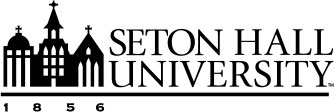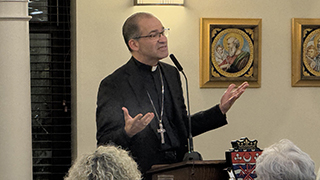Seton Hall University Recognized With Two Distinctions by Carnegie Foundation and ACE
Thursday, May 1, 2025
 On April 24, the Carnegie Foundation for the Advancement of Teaching and the American
Council on Education (ACE) announced the second phase in The Carnegie Classification of Institutions of Higher Education, as the organizations
embrace new methodologies more reflective of the complexities and multidimensional
nature of higher education institutions since those rankings were established in 1973.
Seton Hall University received two distinctions in the new 2025 Carnegie Classifications.
On April 24, the Carnegie Foundation for the Advancement of Teaching and the American
Council on Education (ACE) announced the second phase in The Carnegie Classification of Institutions of Higher Education, as the organizations
embrace new methodologies more reflective of the complexities and multidimensional
nature of higher education institutions since those rankings were established in 1973.
Seton Hall University received two distinctions in the new 2025 Carnegie Classifications.
Seton Hall was designated as one of 479 “Opportunity Colleges and Universities” in
the new Student Access and Earnings classification for its success in fostering social
mobility and competitive earnings outcomes, placing Seton Hall in the top 16 percent
of over 3,000 classified institutions. Specifically, this new category identifies
institutions that provide higher access to students who receive Pell Grants and/or
come from racially/ethnically underrepresented backgrounds, as well as higher earnings
among graduates compared to their demographic and economic peers. Ratios are calculated
for both these dimensions to determine which of six categories an institution falls.
Opportunity Colleges and Universities, including Seton Hall, are institutions identified
as providing greater access for students from lower socioeconomic and historically
underrepresented backgrounds, as well as greater prospects for their students to earn
more competitive wages. Nationally, only 81 (or 15%) of all Research Universities,
like Seton Hall, were so recognized, with just eight Catholic research institutions
receiving this acknowledgment. Seton Hall is also one of the five four-year institutions
in New Jersey that earned the Opportunity Colleges and Universities designation.
“With this redesign of the Carnegie Classifications, we set out to measure what matters,”
said Mushtaq Gunja, executive director of the Carnegie Classification systems and
senior vice president at ACE. “Nowadays, institutions can’t be reduced down to the
highest degree they award because they exist to serve a wide range of students in
a wide variety of ways. Using multiple factors in how we classify institutions is
an essential step toward making the classifications more useful to researchers, policymakers,
funding agencies and others.”
In addition to receiving this designation, Seton Hall was also identified as one of
100 institutions — among three percent of all U.S. colleges and universities — that
received the new institutional classification as a “Mixed Undergraduate/Graduate-Doctoral
Medium” institution, reflecting the University’s distinctive academic profile and
comprehensive scope. The classification reflects institutions that award degrees at
all levels, including doctorates, across a broad array of programs, while maintaining
an enrollment between 4,000 and 20,000 students.
High Research Activity On the Rise
Seton Hall continues to be recognized as an R2 “high research activity” institution
by Carnegie Foundation and ACE. Research activity was a metric used in the base system
and was announced separately in February. Since these new classifications no longer include research in its methodology, 2025
research activity designations will continue to be published separately.
The R2 “high research activity” designation continues to place Seton Hall among top
national institutions — those receiving at least $5 million in total R&D funding and
awarded at least 20 research/scholarship doctorates annually. In fact, the University
surpassed that goal in the past academic year with $10 million in grants, by attracting
18 research awards which enabled funders to hire exceptional faculty members who engage
in original research and teaching as well as engage our exceptional students in competitive
research. More information about 2025 Carnegie Classifications, including the methodology,
can be found here.
“These combined recognitions reflect the comprehensive strength of Seton Hall,” said
Monsignor Joseph R. Reilly, S.T.L., Ph.D., president of Seton Hall University. “They affirm our Catholic mission
to be a university that not only advances knowledge through research but also broadens
access and delivers meaningful outcomes for our students. We are proud to stand among
a select group of institutions that balance academic excellence, opportunity and impact.”
About the Carnegie Foundation for the Advancement of Teaching
The mission of the Carnegie Foundation is to catalyze transformational change in education
so that every student has the opportunity to live a healthy, dignified, and fulfilling
life. Enacted by an act of Congress in 1906, the Foundation has a rich history of
driving transformational change in the education sector, including the establishment
of TIAA-CREF and the creation of the Education Testing Service, the GRE, Pell Grants,
and the Carnegie Classifications for Higher Education.
About the American Council on Education
ACE is a membership organization that leads higher education with a united vision
for the future, galvanizing our members to make change and collaborating across the
sector to design solutions for today’s challenges, serve the needs of a diverse student
population, and shape effective public policy. As the major coordinating body for
the nation’s colleges and universities, our strength lies in our diverse membership
of more than 1,600 colleges and universities, related associations, and other organizations
in America and abroad. ACE is the only major higher education association to represent
all types of U.S. accredited, degree-granting colleges and universities. For more
information, please visit www.acenet.edu or follow ACE on X (formerly known as Twitter)
@ACEducation and LinkedIn.
Categories: Education, Research






